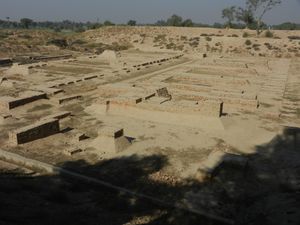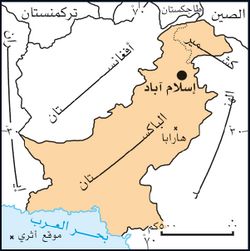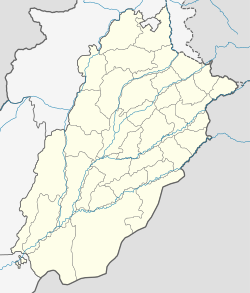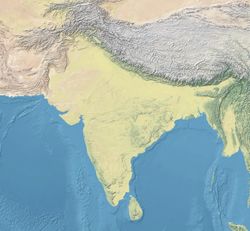هرپة
هرپه أو هارابا (تُنطق [ɦəɽəppaː]؛ أردو: ہڑپّہ؛ بالپنجابي: ਹੜੱਪਾ؛ إنگليزية: Harappa) واحداً من ثلاثة مواقع أثرية يضم كل منها بقايا إحدى المدن الرئيسة الثلاث التي قامت في وادي السند في شبه القارة الهندية، إبان عصور حضارتها القديمة (نحو 2300 - 1700 ق.م.)، والموقعان الآخران هما موهنجو-دارو Mohenjo- Daro، على بعد نحو 644 كم إلى الجنوب الغربي من هاراپا، ولوثال Lothal ويضم الموقع الأخير بقايا مدينة قامت على ما يمكن أن يكون فرعاً قديماً لنهر بهوگاڤا Bhogava قرب شواطئ خليج كامبي Cambay. وقد اكتشف في هذا الموقع حوض للسفن ومرفأ كبير شيد رصيفه بالآجر، ومن دون شك كان هذا الميناء منفذاً لحضارة وادي السند القديمة - بمدينتيها الرئيسيتين هارابا وموهنجو-دارو - إلى بحر العرب والخليج العربي وصولاً إلى بلاد الرافدين. يقوم موقع هاراپا على ضفة نهر رافي Rafi أحد روافد نهر السند Indus، الذي يجري في پنجاب، پاكستان. ويبعد هذا الموقع نحو 480 كم إلى الشمال - الغربي من مدينة دلهي الحالية في الهند.[1][2]
ہڑپّہ (أردو) ਹੜੱਪਾ (پنجابي) | |
 صوامع الغلال في هرپة والقاعة الكبرى | |
 | |
| المكان | ضلع ساهيوال، پنجاب، پاكستان |
|---|---|
| الإحداثيات | 30°37′44″N 72°51′50″E / 30.62889°N 72.86389°ECoordinates: 30°37′44″N 72°51′50″E / 30.62889°N 72.86389°E |
| النوع | مستوطنة |
| المساحة | 100 ha (250 acres) |
| التاريخ | |
| الفترات | الهرپية الأولى إلى الهرپية الخامسة |
| الثقافات | حضارة وادي السند |
| ملاحظات حول الموقع | |
| الحالة | أطلال |
| الملكية | مفتوح للعامة |
| الاتاحة للعامة | نعم |
The site of the ancient city contains the ruins of a Bronze Age fortified city, which was part of the Harappan civilisation centred in Sindh and the Punjab, and then the Cemetery H culture.[3] The city is believed to have had as many as 23,500 residents and occupied about 150 hectares (370 acres) with clay brick houses at its greatest extent during the Mature Harappan phase (2600 BCE – 1900 BCE), which is considered large for its time.[4][5] Per archaeological convention of naming a previously unknown civilisation by its first excavated site, the Indus Valley Civilisation is also called the Harappan Civilisation.
The ancient city of Harappa was heavily damaged under British and French rule, when bricks from the ruins were used as track ballast in the construction of the Lahore–Multan Railway[بحاجة لمصدر]. The current village of Harappa is less than 1 km (0.62 mi) from the ancient site. Although modern Harappa has a legacy railway station from the British Raj period, it is a small crossroads town of 15,000 people today. In 2005, a controversial amusement park scheme at the site was abandoned when builders unearthed many archaeological artefacts during the early stages of building work.[6]
. . . . . . . . . . . . . . . . . . . . . . . . . . . . . . . . . . . . . . . . . . . . . . . . . . . . . . . . . . . . . . . . . . . . . . . . . . . . . . . . . . . . . . . . . . . . . . . . . . . . . . . . . . . . . . . . . . . . . . . . . . . . . . . . . . . . . . . . . . . . . . . . . . . . . . . . . . . . . . . . . . . . . . . .
التاريخ
The Harappan Civilization has its earliest roots in cultures such as that of Mehrgarh, approximately 6000 BCE. The two greatest cities, Mohenjo-daro and Harappa, emerged ح. 2600 BCE along the Indus River valley in Punjab and Sindh.[7] The civilization, with a possible writing system, urban centres, drainage infrastructure and diversified social and economic system, was rediscovered in the 1920s also after excavations at Mohenjo-daro in Sindh near Larkana, and Harappan cities, in west Punjab south of Lahore. A number of other sites stretching from the Himalayan foothills in the east Punjab, India in the west, to Gujarat in the south and east, and to Pakistani Balochistan in the west have also been discovered and studied. Although the archaeological site at Harappa was damaged in 1857[8] when engineers constructing the Lahore-Multan railroad used brick from the Harappa ruins for track ballast, an abundance of artefacts have nevertheless been found.[9]
Because of the reduced sea-levels, certain regions in the late Harappan period were abandoned .[10] Towards its end, the Harappan civilization lost features such as writing and hydraulic engineering.[11] As a result, the Ganges Valley settlement gained prominence and Ganges' cities developed.[10]
The earliest recognisably Harappan sites date to 3500 BCE. This early phase lasts till around 2600 BCE. The civilization's mature phase lasted from 2600 BCE to 2000 BCE. This is when the great cities were at their height. Then, from around 2000 BCE, there was a steady disintegration that lasted till 1400 BCE – what is usually called Late Harappan.[12] There is no sign that the Harappan cities were laid waste by invaders. The evidence strongly points to natural causes. A number of studies show that the area which is today the Thar Desert was once far wetter and that the climate gradually became drier.[13]
الثقافة والاقتصاد
قامت هاراپا مع موهنجو-دارو بالدور المركزي لحضارة وادي السند التي نشأت في حوض نهر السند وروافده، وهذا الحوض سهل رسوبي يماثل في خصائصه الطبيعية السهل الرسوبي في جنوبي العراق، موطن المدن الأولى في حضارة بلاد الرافدين. وشملت حضارة وادي السند أيضاً مواقع على امتداد الساحل الغربي لشبه القارة الهندية فضلاً عن مواقع بعيدة في الشرق. وفي الوقت الذي وجدت فيه علاقات تجارية لحضارة وادي السند مع بلاد الرافدين القديمة - التي تطلق نصوصها المسمارية اسم ملوخا Melukha على تلك المنطقة - احتفظت مراكز تلك الحضارة، ومنها هاراپا بصلات تجارية مع مناطق أقل تحضراً منها للحصول على المواد الأولية التي تحتاج إليها لصناعاتها اليدوية وهكذا كانت لها صلات مع مناطق في الهند وأفغانستان وإيران وشبه الجزيرة العربية.
تدل المكتشفات الأثرية التي أدت إليها تنقيبات موقع هاراپا على أن النحاس كان مستعملاً في صنع بعض الأدوات، ولكنها كانت أدوات بسيطة وغير شائعة على نطاق واسع، ولعل هذا التأخر في تصنيع النحاس يعود إلى تكاليف استيراده الباهضة من أماكن استخراجه، أما الأدوات الأكثر شيوعاً فكانت النصال الحجرية المعدة من لب القطع الصوانية، واكتشفت كميات من خرز العقيق المحززة والمعدة للتصدير على الأرجح. القطع الفخارية كانت مصنوعة غالباً بوساطة الدولاب، ومعظمها من النوع المطلي باللون الأحمر وتحمل رسوماً باللون الأسود لأشكال حيوانية ونباتية على وجه الخصوص. ومن المواد المكتشفة أيضاً الدمى الطينية التي تمثل أشخاصاً أو طيوراً وحيوانات وأحياناً عربات، لقد قدمت بعض مدن الرافدين الجنوبية وعيلام دليلاً على وجود مواد من وادي السند، مثل الأختام المنبسطة, ولكن لم تكتشف مواد من حضارة بلاد الرافدين في هاراپا أو في مواقع حضارة وادي السند الأخرى باستثناء بعض الأختام الأسطوانية المصنوعة محلياً مع مشاهد فنية منقوشة عليها، تتضمن موضوعات من حضارة بلاد الرافدين، وتدل الطبقات العليا في موقع هاراپا على الانهيار المفاجئ لحضارة وادي السند في نهاية القرن الثامن عشر قبل الميلاد، بسبب قدوم القبائل الآرية على وجه الاحتمال. فتلك الطبقات لا تتضمن سوى بقايا أكواخ شيدت بمخطط غير متناسق.
Trade
The Harappans had traded with ancient Mesopotamia, especially Elam, among other areas. Cotton textiles and agricultural products were the primary trading objects. The Harappan merchants also had procurement colonies in Mesopotamia as well, which served as trading centres.[14] They also traded extensively with people living in southern India, near modern-day Karnataka, to procure gold and copper from them.[بحاجة لمصدر]
الآثار
The excavators of the site have proposed the following chronology of Harappa's occupation:[5]
- Ravi Aspect of the Hakra phase, c. 3300 – 2800 BCE.
- Kot Dijian (Early Harappan) phase, c. 2800 – 2600 BCE.
- Harappan Phase, c. 2600 – 1900 BCE.
- Transitional Phase, c. 1900 – 1800 BCE.
- Late Harappan Phase, c. 1800 – 1300 BCE.
Period 1 occupation was thought to be around 7 to 10 hectares, but following excavations and findings of pottery in Mound E, along with previously found Mound AB pottery, suggest Ravi/Hakra phase would have been extended, together in both mounds, to 25 hectares.[15]
Period 2, Kot Diji phase, was extended in the same two mounds, AB and E, covering over 27 hectares.[16]
In Period 3, Harappa phase, the settlement reached 150 hectares.[17]
By far the most exquisite and obscure artefacts unearthed to date are the small, square steatite (soapstone) seals engraved with human or animal motifs. A large number of seals have been found at such sites as Mohenjo-Daro and Harappa. Many bear pictographic inscriptions generally thought to be a form of writing or script.[بحاجة لمصدر] Despite the efforts of philologists from all parts of the world, and despite the use of modern cryptographic analysis, the signs remain undeciphered. It is also unknown if they reflect proto-Dravidian or other non-Vedic language(s). The ascribing of Indus Valley Civilisation iconography and epigraphy to historically known cultures is extremely problematic, in part due to the rather tenuous archaeological evidence for such claims, as well as the projection of modern South Asian political concerns onto the archaeological record of the area. This is especially evident in the radically varying interpretations of the Harappan material culture, as seen from both Pakistan- and India-based scholars.[البحث الأصلي؟][بحاجة لمصدر]
يصل أعلى ارتفاع في موقع هاراپا إلى 15م، وهو أكبر حجماً من موقع موهنجو-دارو. وقد بدأت التنقيبات الأثريه في هذا الموقع في العشرينيات من القرن العشرين، وبعد فترة انقطاع استؤنف التنقيب فيه من قبل مورتيمر ويلر M.Wheeler في عام 1946. وكشفت التنقيبات عن قلعة المدينة وهي أعلى جزء فيها وتحتل الجهة الجنوبية الغربية من المدينة. وهذه القلعة موضع محصن بسور ضخم يبلغ عرضه 12م، مشيد من الآجر غير المشوي (اللبن)، لكن واجهته مشيدة بالآجر المشوي. وضمت القلعة أبنية إدارية يرجح أنها كانت مقراً للنخبة الحاكمة التي لا تتوفر معلومات عن تكوينها حتى اليوم. إلى الشمال من القلعة اكتشفت بقايا صوامع ضخمة لخزن الحبوب يدل وجودها على سيطرة محكمة للدولة على الإنتاج، وإلى جانب تلك الصوامع اُكتشف مجمع سكني يتألف من أكواخ بغرفة واحدة لكل منها, ويبدو أن هذا المجمع كان مخصصاً للعاملين في الصوامع.
المدينة في هاراپا محاطة بسور مشيد بالآجر وتضم أحياء تتخللها شوارع مستقيمة متقاطعة عمودياً مع شوارع ثانوية متفرعة عنها. البيوت مختلفة الحجوم وتراوح ما بين بيوت تتألف من غرفة واحدة إلى قصور متعددة المرافق يتوسط كلاً منها فناء مفتوح. ويلاحظ في تخطيط البيوت في هاراپا وجود حمام في كل بيت تقريباً، ولهذه الحمامات أنظمة تصريف للمياه تربطها قنوات بشبكة من المجاري التي تمر تحت الشوارع الرئيسة لتصرف المياه إلى خارج المدينة. ووجدت مقابر لدفن الأموات فريدة من نوعها في حضارة وادي السند، وذلك إلى الجنوب من المدينة. وهناك أيضاً مقبرة للدفن الجزئي، أي دفن الأوصال البشرية، ولكن لم يعثر فيها على فخار من حضارة السند القديمة، ويرجع تأريخها إلى المرحلة اللاحقة التي أعيد فيها استيطان هاراپا، ولعلها تعود إلى الأقوام الآرية التي حلت هناك.
In February 2006 a school teacher in the village of Sembian-Kandiyur in Tamil Nadu discovered a stone celt (tool) with an inscription estimated to be up to 3,500 years old.[18] [19] Indian epigraphist Iravatham Mahadevan postulated that the four signs were in the Indus script and called the find "the greatest archaeological discovery of a century in Tamil Nadu".[18] Based on this evidence, he went on to suggest that the language used in the Indus Valley was of Dravidian origin. However, the absence of a Bronze Age in South India, contrasted with the knowledge of bronze making techniques in the Indus Valley cultures, calls into question the validity of this hypothesis.
The area of the late Harappan period consisted of the areas of the Daimabad, Maharashtra, and Badakshan regions of Afghanistan. The area covered by this civilisation would have been very large with a distance of around 2,400 kilometres (1,500 mi).[20]
رموز مبكرة قد تكون أقدم كتابة في التاريخ
كانت هاراپا مركزاً رئيساً للحضارة الثالثة التي توصلت إلى التدوين من بعد حضارتي بلاد الرافدين وبلاد النيل، وربما كانت فكرة الكتابة في تلك الحضارة مستوحاة من الكتابة المسمارية في بلاد الرافدين وعيلام، لكنها بالتأكيد تمثل ابتكاراً محلياً خاصاً بوادي السند.[21] وقد وجدت تلك الكتابة على بعض الأختام وفي نصوص اقتصادية ولكن عدد نصوصها لا يكفي لحل رموزها. وكل ما يمكن قوله حالياً عن كتابة حضارة وادي السند أنها مقطعية على الأرجح. ويفترض بعض الباحثين أن لغة تلك الكتابة هندو-أوروبية. وإذا صح هذا الافتراض ربما يمكن أن يعد أصحاب هذه الحضارة القديمة أسلافاً للآريين الذين نقلوا تراثهم الديني إلى سكان الهند اللاحقين. These primitive symbols are placed slightly earlier than the primitive writing of the Sumerians of Mesopotamia, dated c.3100 BCE.[21] These markings have similarities to what later became Indus Script which has not been completely deciphered yet.[21]
ملاحظات
- أقدم تأريخ بالكربون المشع مذكور على الإنترنت هو 2725±185 ق.م. (غير معاير) أو 3338، 3213، 3203 ق.م. معاير، giving a midpoint of 3251 BCE. Kenoyer, Jonathan Mark (1991) Urban process in the Indus Tradition: A preliminary report. في حفريات هرپة، 1986–1990: A multidisciplinary approach to Second Millennium urbanism, edited by Richard H. Meadow: 29–59. Monographs in World Archaeology No.3. Prehistory Press, Madison Wisconsin.
- Periods 4 and 5 are not dated at Harappa. The termination of the Harappan tradition at Harappa falls between 1900 and 1500 BCE.
- موهنجو-دارو هي مدينة رئيسية أخرى من نفس الفترة، تقع في مقاطعة السند في پاكستان. One of its most well-known structures is the Great Bath في موهنجو-دارو.
- Dholavira is another ancient town belonging to Indus Valley Civilisation, established in India. The Harappans used roughly the same size bricks and weights as were used in other Indus cities, such as Mohenjo Daro and Dholavira. These cities were well planned with wide streets, public and private wells, drains, bathing platforms and reservoirs.
. . . . . . . . . . . . . . . . . . . . . . . . . . . . . . . . . . . . . . . . . . . . . . . . . . . . . . . . . . . . . . . . . . . . . . . . . . . . . . . . . . . . . . . . . . . . . . . . . . . . . . . . . . . . . . . . . . . . . . . . . . . . . . . . . . . . . . . . . . . . . . . . . . . . . . . . . . . . . . . . . . . . . . . .
المصادر
- نائل حنون. "هارابا". الموسوعة العربية.
- ^ Giosan, L., Clift, P. D., Macklin, M. G., Fuller, D. Q., Constantinescu, S., Durcan, J. A., ... & Syvitski, J. P. (2012). Fluvial landscapes of the Harappan civilization. Proceedings of the National Academy of Sciences, 109(26), E1688-E1694.
- ^ Dales, George F. (June 1962). "Harappan Outposts on the Makran Coast". Antiquity. 36 (142): 86–92. doi:10.1017/s0003598x00029689. ISSN 0003-598X. S2CID 164175444.
- ^ Basham, A. L.; Dani, D. H. (Winter 1968–1969). "(Review of) A Short History of Pakistan: Book One: Pre-Muslim Period". Pacific Affairs. 41 (4): 641–643. doi:10.2307/2754608. JSTOR 2754608.
- ^ Fagan, Brian (2003). People of the earth: an introduction to world prehistory. Pearson. p. 414. ISBN 978-0-13-111316-9.
- ^ أ ب خطأ استشهاد: وسم
<ref>غير صحيح؛ لا نص تم توفيره للمراجع المسماةunesco - ^ Tahir, Zulqernain. 26 May 2005. Probe body on Harappa park, Dawn. Retrieved 13 January 2006. Archived 11 مارس 2007 at the Wayback Machine
- ^ Beck, Roger B. (1999). World History: Patterns of Interaction. Evanston, IL: McDougal Littell. ISBN 978-0-395-87274-1.
- ^ Michel Danino. The Lost River. Penguin India.
- ^ Kenoyer, J.M., 1997, Trade and Technology of the Indus Valley: New insights from sand, clay, stones and were baked at very high temperature. As early as 1826 Harappa, located in west Punjab, attracted the attention of Daya Ram Sahni, who gets credit for preliminary excavations of Harappa.
- ^ أ ب Mcintosh, Jane (2008). The Ancient Indus Valley New Perspectives. Routledge. p. 94. ISBN 978-1-57607-907-2.
- ^ Mcintosh, Jane (2008). The Ancient Indus Valley New Perspectives. Routledge. p. 101. ISBN 978-1-57607-907-2.
- ^ Culture change during the Late Harappan period at Harappa: new insights on Vedic Aryan issues, Routledge, 2004-08-02, pp. 33–61, doi:, ISBN 978-0-203-64188-0, http://dx.doi.org/10.4324/9780203641880-7, retrieved on 2022-03-30
- ^ Q., Madella, Marco Fuller, Dorian (2006-01-18). Palaeoecology and the Harappan Civilization of South Asia: a reconsideration. Elsevier. OCLC 1103344632.
{{cite book}}: CS1 maint: multiple names: authors list (link) - ^ Mcintosh, Jane (2008). The Ancient Indus Valley New Perspectives. ABC-CLIO. pp. 183–184, 394. ISBN 978-1-57607-907-2.
- ^ Kenoyer, J. M., (June 6, 2023). "Indus Socio-Economic, Political and Ideological Organization", in ARWA Association, min. 5:48 to 6:41, "Period 1 Ravi/Hakra Phase, area greater than 10 to 25+ hectares, possibly divided into two mounds, one to the north, Mound AB and the other to the southeast, Mound E."
- ^ Kenoyer, J. M., (June 6, 2023). "Indus Socio-Economic, Political and Ideological Organization", in ARWA Association, min. 8:04 to 9:30.
- ^ Fagan, Brian (2003). People of the earth: an introduction to world prehistory. Pearson. p. 414. ISBN 978-0-13-111316-9.
- ^ أ ب Subramaniam, T. S. (1 May 2006). ""Discovery of a century" in Tamil Nadu". The Hindu. Archived from the original on 15 June 2006. Retrieved 21 May 2008.
- ^ Subramaniam, T. S. (1 May 2006). "Significance of Mayiladuthurai find". The Hindu. Archived from the original on 30 April 2008. Retrieved 23 May 2008.
{{cite news}}: CS1 maint: unfit URL (link) - ^ Kulke, Herman (2004). History of India. Routledge. p. 4. ISBN 978-0-415-32920-0.
- ^ أ ب ت BBC, UK website. "Earliest writing found". BBC News. Retrieved 17 July 2012.
انظر أيضاً
- تشارلز ماسون – أول مستكشف أوروپي لهرپة
- Dholavira
- لوثال
- العمارة الهرپية
- Mandi, Uttar Pradesh, India
- مهرگره
- Sheri Khan Tarakai
- موهنجو-دارو
- Sokhta Koh
- Kalibangan
- Rakhigarhi
المراجع
<ref> بالاسم " unesco " المحددة في <references> لها سمة المجموعة " " والتي لا تظهر في النص السابق.وصلات خارجية
- Harappa.com
- "Harappa Town Planning"-article by Dr S. Srikanta Sastri
- Art of the Bronze Age: Southeastern Iran, Western Central Asia, and the Indus Valley, an exhibition catalog from The Metropolitan Museum of Art (fully available online as PDF), which contains material on Harappa


